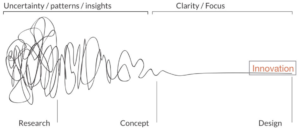Albert Einstein once said: “If I had an hour to solve a problem I’d spend 55 minutes thinking about the problem and 5 minutes thinking about solutions.”
But, according to Tony Robbins most of us do the opposite: “Leaders spend 5% of their time on the problem and 95% of their time on the solution.”
In a fast-paced industry, a culture of always doing and being increasingly time poor, Tony Robbins’ quote probably speaks to many of us – always be moving forward, action over reflection, move fast and break things, iteration over innovation. But in saying that, Einstein’s is much closer to a “Design Thinking Approach” – deeply understand the problem and the very heart of why – and your solution will be more tightly focused and valuable.
I’ve seen some insightful shifts in the last 10+ years, but the major one is the use of technology — the use of technology to solve real business problems — rather than it just being the problem.
Before returning to Australia 10 years ago, my previous six were spent in the UK working with a great software company that focused on building the best technical solution for our customers. Arriving at DiUS, those same principles rang true, except for my introduction to the “Agile methodology” mindset, something I wasn’t familiar with but totally made sense. Collaboratively working, architecting, designing and frequently delivering value and features – encompassing engineering rigour, ways of working and building an enduring culture became the basis of the new world for me.
But, the past five or so years has seen an industry mindset shift in the importance of Experience Design — better understanding your market segment, knowing who you are building for to ensuring its solving a real problem — with technology taking a back seat due to its advancements during this time.
Let’s focus on solving the problem; the tech will sort itself out
Thinking back to my early conversations with customers, the majority had been led down the technology path rather than looking at the problem first, but that was the mindset back then.
I remember a particular journey a customer had taken; they understood (so they thought) the customer problem but decided to build out a great product offering for their market — 18 months of development later, three months post launch they had single digit customer acquisition. A quick pivot to reevaluate their product and focus on customer feedback and suffice to say that a “customer first” approach was established across the business.
I have been part of many of these conversations over the years, but to have those technology-first customers (“build it and they will come”) now want to look at ways to validate and de-risk their investment, speaks volumes of the impact that this mindset shift has had on all industries.
Recently we supported a customer with an innovative prototyped idea which was technology led — there was minimal understanding on how this would resonate with their customers (we suggested this was a risk and gap) but they pushed ahead anyway with a soft launch. As you might have guessed, they too experienced a lack of customer uptake and pivoted to evaluating these gaps, focusing more on the problem they are solving, getting customer feedback but also looking at how this innovative offering to market would ensure its success and customer acquisition.
Fast forward to three months post soft launch, they had released their product globally to different market segments with great success — all through employing a User Experience first approach. Don’t get me wrong, we know the importance of technology and a great technical solution, but with the speed in which technology is now moving — to keep up, we need to increase our focus on these other facets.
Riding the next technology wave
The next wave we are riding is all around data, mining what we have, where can we source more, how the Internet of Things (IoT) and collection of that data can help drive new insights and when you have all that data, what do you do with it? Say hello to Machine Learning (ML).
Technology, as much as its tantalising, exciting, invigorating and innovative, will always play second fiddle to ensuring you are solving a real business/industry problem that you have researched, user tested, collected data on and validated.
So with this “next wave” let’s not continue to make these same mistakes, but ask:


- Do we have a clear problem to solve, and how will this solve it?
- What tools and techniques can we use to identify valuable problems?
- What positive business or social impact are they trying to solve?
- If we are trying to find a problem using this technology, is it really a problem?
- Are we solution led, rather than problem led?
- Do we have a technical solution already?
- Is there an alternative approach to solving this problem?
- Do we have that data we need?
- What data will be collected?
- Where will it be sourced?
- Do we have a Data Strategy?
Having data, even large amounts of it by itself does nothing without a clear need or problem that can even be re-focused to provide new insights.
In saying that, there are a number of avenues you can take; two that come to mind would be the adoption of agile methodologies for product development, selecting the right framework that you can adapt for your organisation — but also requiring that expertise to help exploit those framework principals is key too.
One that resonates with me and can be adopted across an organisation is the Design Thinking Framework.


“Design thinking minimises the uncertainty and risk of innovation by engaging customers or users through a series of prototypes to learn, test, and refine concepts. Design thinkers rely on customer insights gained from real-world experiments, not just historical data or market research.”
In short, focus on the problem, ensure there is a problem to solve and I’ll guarantee that the technology will sort itself out.





